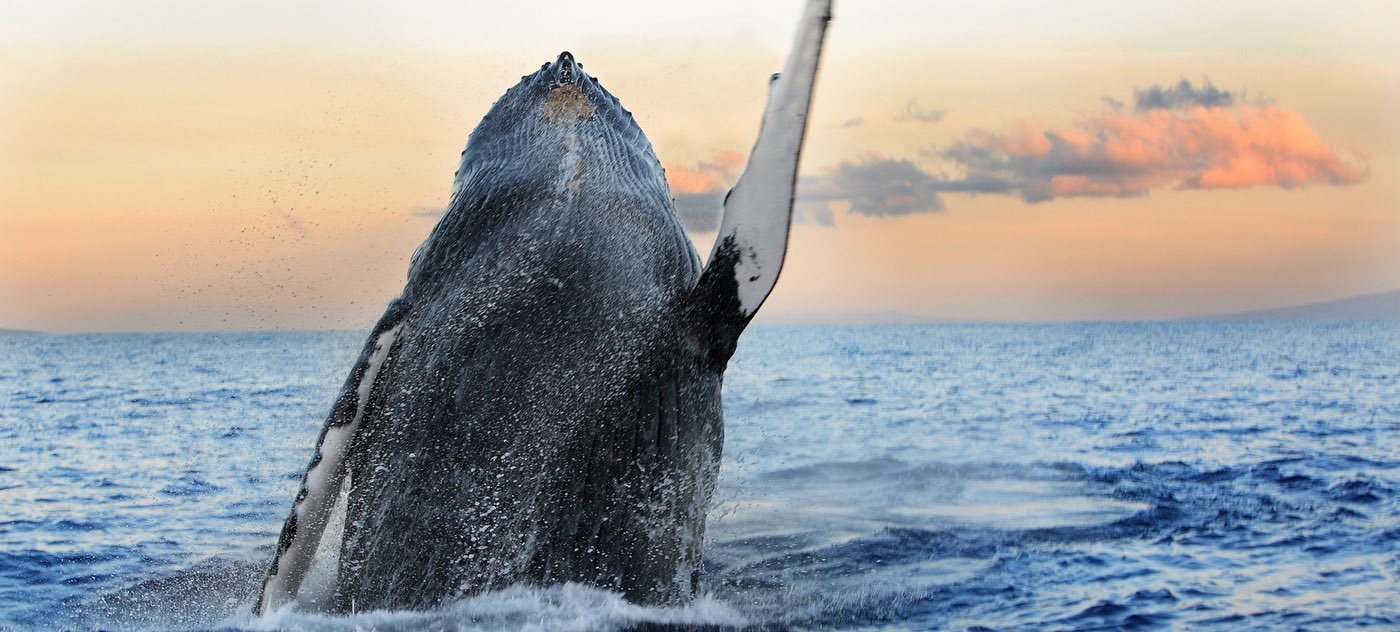All about whales:
- Whales belong to the order Cetacea, which includes whales, dolphins and porpoises.
- The word whale comes from the Old English word whael.
- Whales live in all of the Earth’s oceans.
- The closest living relative to whales is the hippopotamus. They diverged about forty million years ago.
- Whales are either toothed (Odontoceti) or have baleen (Mysticeti).
- Toothed whales feed mostly on fish, squid, other whales and marine mammals, and baleen whales mostly on plankton, small fish and crustaceans.
- A baleen is a comb-like fringe on the upper jaw of the whale used to filter food.
- Whales are mammals, they produce milk, are warm blooded, have lungs for breathing and some even have small hairs.
- Whales have a blowhole which they use to breathe. Baleen whales have two and toothed whales have one.
- They have flippers and have tail fins called flukes that they use to propel themselves through the water. Most species of whales have a dorsal fin on their back.
- The toothed whales include the Sperm whale, the Pygmy Sperm whale and the Beaked whales.

- The baleen whales include the Humpback whale, Gray whale, Common Minke whale, Southern Minke whale, Bowhead whale, North Atlantic Right whale, North Pacific Right whale, Southern Right whale, Pygmy Right whale, Fin whale, Sei whale, Bryde’s whale, Omura’s whale, Eden’s whale, and the Blue whale.
- The Sperm whale is the largest toothed predator on Earth. The famous book Moby Dick tells the story of a Sperm whale and a fisherman.
- The Blue whale, a Baleen whale, is the largest whale of all.
- The Blue whales are the largest animals to have ever lived on Earth.
- The Fin whale is the second largest animal on Earth.
- Indigenous people of the Arctic have traditionally used the meat, blubber, baleen, and oil of baleen whales.
- The life spans of whales can be from 25 to 110 years, but some Bowhead whales live over 200 years.
- A Blue whale can weigh over 150,000 kilograms and be more than 25 meters in length.
- The gestation period in whales can be from 9 to 18 months and the calf can stay with the mother for up to one year or more.
- Males usually mate with multiple females every year, but females only mate every two to three years.
- Calves are regularly born in the spring and summer months.
- The Humpback whale is one of the most recognizable due to the large hump on its dorsal fin.
- The heart of a Blue whale can weigh as much as 350 kilograms or be the size of a small car.
- Some whales like the Beaked whales and Sperm whales can dive two to three kilometers deep for up to two hours or more.

- A Humpback whale’s lungs can hold about 5,000 liters of air.
- The Sperm whale has the largest brain of all animals, weighing up to 10 kilograms.
- The Bowhead whale has the most blubber of all whales, some have up to three feet of thickness. And their baleen plates can reach 5 meters in length.
- The blubber in whales serves as an energy reserve and insulation.
- Most whales, especially Baleen whales, migrate long distances from their cold-water feeding grounds to warm-water breeding grounds each year.
- The longest confirmed migration is made by the Humpback whales that feed in the Antarctic waters and swim north to breed off Colombia and Panama.
- Some whales can travel as fast as 20 knots per hour.
- Whales can jump high, or breach, out of the water. Whales also thrust their tails out of the water and slap the water’s surface. They communicate with each other using lyrical sounds and these sounds can be heard for many miles.
- Humpback whales and Blue whales can travel thousands of miles without feeding.
- Sperm whales make the loudest sounds. They have been recorded making a noise at 230 decibels.
- The most complex songs and beautiful songs that include recognizable sequences of squeaks, grunts, and other sounds are from male Humpback whales. The songs have the largest range of frequencies used by whales, ranging from 20-9,000 hertz.
- Whales are known to teach, learn, cooperate, scheme, and grieve.
- It is thought that whales sleep with one half of their brain resting while the other half keeps them from drowning and aware of predators.
- They migrate to Baja every year and their round-trip journey can be from 15,000-20,000 kilometers. And it takes them from five to eight weeks to reach the breeding sites.
- There are two groups of Pacific Gray whales, the east and west groups.
- The Gray whale spends a few months in the lagoons of Baja. Some spots are San Ignacio lagoon, Ojo de Liebre and Magdalena Bay. The migration begins around October and finishes about April. They choose these sites due to their warm and calm waters.
- They usually travel in groups of two or three at a speed of about 3 to 5 miles per hour and submerge for about 5 minutes at a time, or for 15 minutes or longer to feed.
- Gray whales can be 15 meters long and weigh 35 tons.
- They are Baleen whales and reach maturity at about 8 or 9 years old. And the females give birth to one calf about every two years.
- Newborns can be 5 meters long and weigh 1000 kilograms. And due to those beautiful baby whales, we get their mom’s visit to Baja every year!
 Make this vacation memorable and unforgettable by planning some whale watching, either by booking a whale watching tour on a boat in the day time combined with some snorkeling, or at sunset time on a dinner cruise around the famous Arch. Or hire an adventure outfitter and do a kayaking trip in the Santa Maria bay and Chileno reef area. Also, maybe rent a car and drive out to the Pacific side and try to observe them from the wonderful beaches there like Cerritos beach, and top it off with a wonderful sunset viewing. Or even take an adventurous plane trip to one of the famous bays that serve as breeding waters. So have great a time with the whales and see you soon. Thanks for choosing your vacation in Cabo![/vc_column_text][/vc_column][/vc_row]]]>
Make this vacation memorable and unforgettable by planning some whale watching, either by booking a whale watching tour on a boat in the day time combined with some snorkeling, or at sunset time on a dinner cruise around the famous Arch. Or hire an adventure outfitter and do a kayaking trip in the Santa Maria bay and Chileno reef area. Also, maybe rent a car and drive out to the Pacific side and try to observe them from the wonderful beaches there like Cerritos beach, and top it off with a wonderful sunset viewing. Or even take an adventurous plane trip to one of the famous bays that serve as breeding waters. So have great a time with the whales and see you soon. Thanks for choosing your vacation in Cabo![/vc_column_text][/vc_column][/vc_row]]]>



